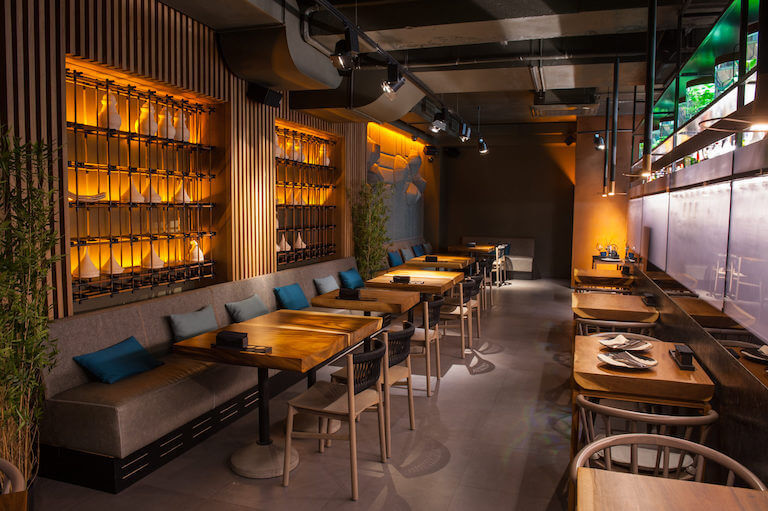Chinese Food Islamabad: Take Pleasure In Authentic Chinese Cuisine at its Best
Chinese Food Islamabad: Take Pleasure In Authentic Chinese Cuisine at its Best
Blog Article
Savor Genuine Oriental Cuisine With a Pan-Asian Twist for a Culinary Adventure
Beginning on a culinary trip via authentic Asian cuisine, boosted with a Pan-Asian twist, provides an one-of-a-kind chance to discover the rich tapestry of flavors that define the area's varied culinary practices. This experience welcomes you to enjoy the splendid balance of tastes-- pleasant, salty, spicy, and sour-- balanced by aromatic natural herbs and spices. Imagine the ingenious combination of Thai curry and ramen or the unforeseen pleasure of sushi burritos. As you contemplate these enticing recipes, think about the cultural narratives and historical influences that form them, each bite supplying a tale waiting to be found.

Discovering Pan-Asian Flavors
In the world of global gastronomy, Pan-Asian food attracts attention for its exceptional diversity and the unified interaction of flavors from various Eastern cultures. This culinary strategy celebrates the one-of-a-kind components and rich practices located throughout the continent, producing a tapestry of preferences that is both enjoyable and intriguing. Trick to Pan-Asian cuisine is its capability to stabilize contrasting tastes-- sweet, salty, spicy, and sour-- while highlighting the quality and high quality of each ingredient.
From the umami-rich soy sauce of Japan to the intense chili peppers of Thailand, Pan-Asian food uses a considerable palette of flavors. These aspects are frequently incorporated in inventive methods, boosting dishes with layers of intricacy. For instance, using great smelling herbs such as lemongrass and cilantro, typical in Vietnamese and Thai food, adds a rejuvenating brightness to dishes, while the unification of coconut milk provides a luscious, rich texture.
The focus on fresh fruit and vegetables and fragrant flavors ensures that each dish is not just a feast for the taste yet also for the senses. Pan-Asian cuisine welcomes diners to start a culinary journey, discovering the huge and differed landscapes of Asian gastronomy with every bite.
Combination Recipes to Try
While Pan-Asian food is commemorated for its standard flavors, the modern-day culinary landscape is increasingly welcoming combination dishes that mix these traditional elements with impacts from other areas. This cutting-edge technique not only honors the rich heritage of Asian cooking arts yet additionally introduces novel preference experiences that appeal to modern palates.
An archetype of such a fusion meal is the Korean-Mexican taco, where seasoned bulgogi beef is wrapped in a cozy tortilla, topped with kimchi and a hot gochujang-infused salsa. This mix marries the vibrant, mouthwatering flavors of Korea with the vivid, fresh aspects of Mexican food. Likewise, sushi burritos have gained appeal, joining together the fragile creativity of Japanese sushi with the passionate, hand-held convenience of a burrito, typically featuring combination components like tempura shrimp and avocado with a drizzle of wasabi mayo.
Another notable recipe is Thai curry ramen, which infuses the luscious, fragrant spices of Thai curry into the calming brew of conventional Japanese ramen, developing a harmonious mix that entices the senses. These blend dishes extend beyond mere novelty; they stand for a culinary discussion in between societies, urging exploration and development on the planet of Pan-Asian food.
Essential Components and Flavors
To genuinely value Pan-Asian food, one must understand the vital active ingredients and spices that form its foundation. This varied culinary style draws from a rich tapestry of Asian traditions, using an unified mix of textures and flavors. Key ingredients view it include soy sauce, fish sauce, and oyster sauce, which pass on a full-flavored umami depth vital to Eastern meals. Corresponding to these are rice vinegar and mirin, providing a fragile acidity and sweet taste.
Aromatic elements are essential, with garlic, lemongrass, and ginger being common throughout various Pan-Asian recipes. These ingredients give an aromatic base that enhances the intricacy of flavors. Seasonings such as star anise, cardamom, and cinnamon present warmth and personality, echoing impacts from regions like China and India.

Food Preparation Methods and Tips
Understanding the art of Pan-Asian food requires knowledge with its distinctive food preparation methods, each contributing to the lively tapestry of flavors this cooking custom is commemorated for. Central to these techniques is the stir-fry, a fast food preparation technique that preserves the dietary integrity and brilliant shades of active ingredients. Making use of a frying pan, the stir-fry method permits even heat distribution, vital for accomplishing the particular structure and taste balance of Pan-Asian meals.
One more essential method is steaming, particularly prevalent in Chinese cuisine. This gentle method keeps the all-natural tastes and nutrients of active ingredients, making it ideal for fish and shellfish and veggies. Dumplings, a precious staple, usually profit from steaming, causing soft, delicious appearances.
Barbecuing, additionally indispensable, presents great smoky depths to dishes such as Korean bulgogi or Japanese yakitori (asian fusion restaurant). This technique frequently involves seasoning active ingredients, enabling flavors to penetrate deeply prior to food preparation over an open fire or warm plate
Last but not least, understanding the art of stabilizing tastes-- sweet, sour, salty, bitter, and umami-- is long john silvers near me critical. Properly layering these elements can boost a meal from common to extraordinary, supplying a complicated and pleasing culinary experience that symbolizes the significance of Pan-Asian food.
Eating Experiences Worldwide
Throughout the globe, Pan-Asian food offers an exceptional eating experience, celebrated for its abundant tapestry of flavors and vivid presentations. This cooking sensation has gone beyond cultural limits, capturing the hearts and tastes buds of food fanatics worldwide. In multicultural cities fresh York, London, and Sydney, Pan-Asian restaurants function as melting pots where culinary practices from Thailand, Japan, China, and beyond assemble, giving diners with a diverse mix of recipes that highlight the region's variety.
The worldwide allure of Pan-Asian food lies in its capability to use both credibility and development. Chefs masterfully wed typical ingredients such as lemongrass, soy sauce, and miso with contemporary methods, causing dishes that are both refreshingly brand-new and acquainted. This fusion allows diners to start a cooking journey that appreciates heritage while welcoming modernity.
Moreover, eating experiences are raised with thoughtfully made environments that show the ethos of Pan-Asian visual appeals. From minimal Japanese-inspired interiors to lively Thai-themed areas, each restaurant uses a special atmosphere that matches the cooking offerings. Because of this, customers are not just consuming a meal but partaking in a cultural experience, making Pan-Asian dining an absolutely international phenomenon.
Final Thought
The exploration of Pan-Asian cuisine supplies an extensive understanding of the intricate interplay of tastes and cooking traditions throughout Asia. By embracing combination meals such as Thai curry ramen and sushi burritos, the culinary journey not only highlights the flexibility of standard components yet also showcases ingenious modern-day strategies. This gastronomic journey, enhanced by cooking techniques and necessary flavors, offers an one-of-a-kind chance to value the multiculturalism and culinary creativity that define Pan-Asian cuisine on a global range.
Embarking on a cooking journey through authentic Eastern cuisine, boosted with a Pan-Asian spin, supplies an unique chance to explore the rich tapestry of flavors that specify the region's varied culinary practices.In the world of global gastronomy, Pan-Asian cuisine try these out stands out for its remarkable diversity and the harmonious interplay of flavors from various Eastern cultures. Key to Pan-Asian cuisine is its capacity to stabilize contrasting flavors-- sweet, salty, spicy, and sour-- while highlighting the quality and quality of each component.

Report this page